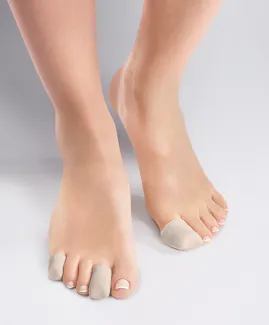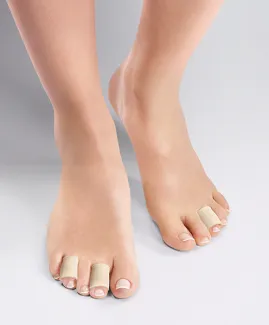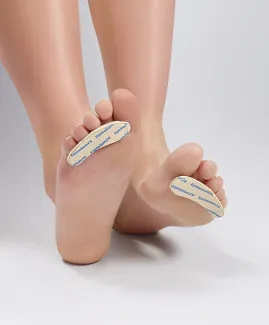
Corns on feet are common foot problems that appear due to high and repeated pressure on a localised area. They are a defensive process of the skin that hardens to protect itself. It happens in the feet but also in the hands or any part of the body. Most of the time, corns are painful and require specific treatments.
How to treat a corn on foot? How to remove a corn on toe and what is the treatment for a soft corn between toes? Discover all the foot corn treatments with Epitact, your foot specialist for 25 years.
Foot corn treatment
In the foot, these areas of thickened skin often appear when there is a conflict between the shoe and the toes. They especially develop when the toes are abnormally bent (hammer toes or claw toes), so the phalanx rubs against the shoe. Corns can also appear between two overlapping toes; they are called soft corns.
How to treat a corn on foot or a corn between toes?
There are several home remedies to fight against corns and recover healthy skin on your feet.
1) The first step in the treatment of a soft corn between toes or a corn on toes is to remove the source of excessive pressure or friction responsible for skin overuse. For example, wear well-fitting shoes, more comfortable and wider to make room for your toes.
If it is not enough to relieve you, the undermentioned EPITACT® protections could improve your comfort.
2) The next step for treating a foot corn consists in removing the dead skin that forms the callosity. To do that, you can use a pumice stone and gently file the corn. Before that, you can soak your feet in warm water to soften your skin and make it easy.
If you have diabetes or fragile and sensitive skin, see a podiatrist. By asking a health professional to take care of your feet, you would avoid hurting you unnecessarily and limit the risks of infection.
Lastly, it is necessary to moisturise and protect the area in the long term. To do so, you can apply a moisturising cream and the EPITACT® patented silicone protections*.
How to treat a foot corn with the EPITACT® corn pads
As we’ve just said, there are protections made up of silicone that are specially developed to prevent or to get rid of corns on your feet.
Soft corn between toes: treatment
To treat a soft corn between toes, you can use the DIGITUBES® protections*. These corn removers include a special silicone gel that distributes pressure and absorbs friction. By limiting such stresses on the skin, the foot corn progressively disappears.
Their distinctive characteristic is that the gel pad only covers half of the protection. It makes it a very thin device that does not add pressure in the shoes.
How to remove a corn on toe?
The most appropriate solution to remove a corn on the toe is the DIGITUBES® sleeves*. They have a very smooth and resistant fabric that provides more comfort and prolongs their lifetime.
Moreover, they are sold in sets of 3 strips to be cut out. With only 1.5 cm of a DIGITUBES® device, you protect your corn for an average of 10 days! Several sizes are available to fit each toe.
How to treat a foot corn at the end of the toe?
If your corn is located at the tip of your toe, choose the Digitops*. These small toe caps made from silicone and fabric have been specifically developed to protect from corns and ingrown toenails. They have no seams and are only 1mm thick: the areas of friction are reduced to a minimum.
How to treat claw or hammer toes?
If your toes are deformed and bent to look like a hammer or a claw, prefer the hammer toe cushions*. This device aims to comfortably extend your toes and avoids painful contact from the shoe.
It also adapts perfectly to the space underneath your toes. It allows to distribute the pressure better and relieves your toes. A flexible elastic to put on the third toe gives perfect holding of the device all day long.
In the end, you’d understand that the best foot corn treatment is prevention. By protecting the sensitive area, you prevent corns and reduce hyperkeratosis. However, if it’s too late, consult a podiatrist who will remove your corn on foot. After that, this area should be regularly moisturised with an appropriate cream and then protected with silicone devices for example. Now that you know how to treat a corn on foot, learn how to avoid it!
*These solutions are class I medical devices that bear the CE marking under this regulation. Carefully read the instructions before use. Manufacturer: Millet Innovation. 01/2022
 Pharmacie
Pharmacie

